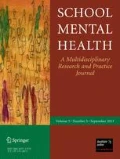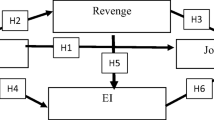Abstract
Uncivil behavior in the classroom is a growing issue among children and youth both academically and developmentally. This unique low-level antisocial behavior may be a precursor to higher-level antisocial behavior, and it is therefore important to have a relevant tool to be able to measure engagement in such behavior in the classroom. Using data from 586 children and youth (46.4% boys) between the ages of 10 and 14 (M = 12.02; SD = 1.35), we conducted a confirmatory factor analysis to validate a scale of classroom incivility consisting of two subscales based on intentionality (intentional and unintentional). We also ensured construct validity of our subscales by exploring HEXACO personality profiles and correlating our measures with both self- and peer-reported variables related to social and mental well-being. Our results highlight that engaging in classroom incivility is positively associated with poorer well-being, antisocial traits and antisocial behavior. Our results also demonstrate distinct personality profiles of students who reported engaging in intentional versus unintentional classroom incivility. This study is an important first step for future research exploring the potential antecedents and implications of engaging in uncivil behavior in the classroom, particularly if such behavior may have potential to escalate into more serious behavior later on.

Similar content being viewed by others
Availability of Data and Material
Due to REB regulations, we are not able to provide public access to our data.
Code Availability
Syntax for all Mplus and SPSS analyses have been included as a supplementary file.
References
AlKandari, N. (2011). The level of student incivility: The need of a policy to regulate college student civility. College Student Journal, 45(2), 257–268.
Allen, A. N., Kilgus, S. P., Burns, M. K., & Hodgson, C. (2019). Surveillance of internalizing behaviors: A reliability and validity generalization study of universal screening evidence. School Mental Health, 11(2), 194–209.
Andersson, L., & Pearson, C. (1999). Tit for tat? The spiralling effect of incivility in the workplace. Academy of Management Review, 24, 452–471.
Bantha, T., Sahni, S. P., & Yadav, M. (2020). Identification of enablers for reducing student incivility in classrooms—An exploratory investigation. International Journal of Higher Education, 9(2), 193–199.
Bingӧl, T., Sӧlkpük Turhan, N., Arslan, N., Öztabak, M. U., & Çetintaș, S. (2018). Sınıf İçi Kaba Davranışlar Ölçeğinin Türkçe’ye Uyarlaması. Sakarya University Journal of Education, 8(1), 165–176.
Bjorklund, W. L., & Rehling, D. L. (2009). Student perceptions of classroom incivility. College Teaching, 58(1), 15–18.
Bjorklund, W. L., & Rehling, D. L. (2011). Incivility beyond the classroom walls. InSight: A Journal of Scholarly Teaching, 6, 28–36.
Burke, L. A., Karl, K., Peluchette, J., & Evans, W. R. (2014). Student incivility: A domain review. Journal of Management Education, 38(2), 160–191.
Clark, C. M. (2008). Faculty and student assessment of and experience with incivility in nursing education. Journal of Nursing Education, 47(10), 458–465.
Clark, C. M., Farnsworth, J., & Landrum, R. E. (2009). Development and description of the incivility in nursing education (INE) survey. Journal of Theory Construction & Testing, 13(1), 7.
Costello, Anna B., & Osborne, Jason. (2005). Best practices in exploratory factor analysis: Four recommendations for getting the most from your analysis. Practical Assessment, Research, and Evaluation, 10(1), 7.
De Vries, R. E., & Born, M. P. (2013). De Vereenvoudigde HEXACO Persoonlijkheidsvragenlijst en een additioneel interstitieel Proactiviteitsfacet. Gedrag & Organisatie, 26(2), 223–245.
Farrell, A. H., Provenzano, D. A., Spadafora, N., Marini, Z. A., & Volk, A. A. (2016). Measuring adolescent attitudes toward classroom incivility: Exploring differences between intentional and unintentional incivility. Journal of Psychoeducational Assessment, 34(6), 577–588.
Feldmann, L. J. (2001). Classroom civility is another of our instructor responsibilities. College Teaching, 49(4), 137–140.
Field, A. (2018). Discovering statistics using IBM SPSS statistics. Thousand Oaks: SAGE Publications.
Goodman, R. (1997). The strengths and difficulties questionnaire: A research note. Journal of Child Psychology and Psychiatry, 38(5), 581–586.
Hartung, C. M., Little, C. S., Allen, E. K., & Page, M. C. (2011). A psychometric comparison of two self-report measures of bullying and victimization: Differences by sex and grade. School Mental Health, 3(1), 44–57.
Hawley, P. H. (2003). Prosocial and coercive configurations of resource control in early adolescence: A case for the well-adapted Machiavellian. Merrill-Palmer Quarterly, 49(3), 279–309.
Hawley, P. H., Little, T. D., & Card, N. A. (2008). The myth of the alpha male: A new look at dominance-related beliefs and behaviors among adolescent males and females. International Journal of Behavioral Development, 32(1), 76–88.
Hirschy, A. S., & Braxton, J. M. (2004). Effects of student classroom incivilities on students. New Directions for Teaching and Learning, 99, 67–76.
Hu, L., & Bentler, P. M. (1998). Fit indices in covariance structure modeling: Sensitivity to underparameterized model misspecification. Psychological Methods, 3(4), 424–453.
Hu, L., & Bentler, P. M. (1999). Cutoff criteria for fit indexes in covariance structure analysis: Conventional criteria versus new alternatives. Structural Equation Modeling, 6(1), 1–55.
Katt, J., Sivo, S., Miller, A. N., Brown, T., Scott, A., & Neel, S. (2018). Refinement of the Classroom Citizenship Behavior Scale. Communication Research Reports, 35(3), 282–291.
Kline, R. B. (1998). Software review: Software programs for structural equation modeling: Amos, EQS, and LISREL. Journal of Psychoeducational Assessment, 16(4), 343–364.
Laverghetta, A. (2018). The relationship between student anti-intellectualism, academic entitlement, student consumerism, and classroom incivility in a sample of college students. College Student Journal, 52(2), 278–282.
Lee, K., & Ashton, M. C. (2012). Getting mad and getting even: Agreeableness and honesty-humility as predictors of revenge intentions. Personality and Individual Differences, 52(5), 596–600.
Lim, S., Cortina, L. M., & Magley, V. J. (2008). Personal and workgroup incivility: Impact on work and health outcomes. Journal of Applied Psychology, 93(1), 95.
Marini, Z. A. (2009). The thing line between civility and incivility: Fostering reflection and self-awareness to create a civil learning community. Collected Essays on Teaching and Learning, 2, 61–67.
Mikami, A. Y., Owens, J. S., Hudec, K. L., Kassab, H., & Evans, S. W. (2020). Classroom strategies designed to reduce child problem behavior and increase peer inclusiveness: Does teacher use predict students’ sociometric ratings? School Mental Health, 12(2), 250–264.
Miller, A. N., Katt, J. A., Brown, T., & Sivo, S. A. (2014). The relationship of instructor self-disclosure, nonverbal immediacy, and credibility to student incivility in the college classroom. Communication Education, 63(1), 1–16.
Muthén, L. K., & Muthén, B. O. (1998–2017). Mplus user’s guide (8th ed.). Los Angeles, CA: Muthén & Muthén.
Myers, S. A., Goldman, Z. W., Atkinson, J., Ball, H., Carton, S. T., Tindage, M. F., et al. (2016). Student civility in the college classroom: Exploring student use and effects of classroom citizenship behavior. Communication Education, 65(1), 64–82.
Nordstrom, C. R., Bartels, L. K., & Bucy, J. (2009). Predicting and curbing classroom incivility in higher education. College Student Journal, 43(1), 74–86.
Pearson, C. M., & Porath, C. L. (2005). On the nature, consequences and remedies of workplace incivility: No time for “nice”? Think again. Academy of Management Executive, 19(1), 7–18.
Prabhaban, N. (2020). Victimization by bullying and non-bullying aggression: An evolutionary psychological perspective. St. Catharines, ON: Brock University.
Roberson, A. J., & Renshaw, T. L. (2019). Initial development and validation of the Student Wellbeing Teacher-Report Scale. School Mental Health, 11(3), 578–599.
Royce, A. P. (2000). A survey on academic incivility at Indiana University: Preliminary report. Bloomington: Center for Survey Research, Indiana University.
Schniering, C. A., & Rapee, R. M. (2002). Development and validation of a measure of children’s automatic thoughts: The Children’s Automatic Thoughts Scale. Behaviour Research and Therapy, 40, 1091–1109.
Spadafora, N., Farrell, A. H., Provenzano, D. A., Marini, Z. A., & Volk, A. A. (2016). Temperamental differences and classroom incivility: Exploring the role of individual differences. Canadian Journal of School Psychology, 33(1), 44–62.
Spadafora, N., Frijters, J. C., Molnar, D. S., & Volk, A. A. (2020). Do little annoyances relate to bullying? The links between personality, attitudes towards classroom incivility, and bullying. The Educational and Developmental Psychologist, 37(1), 30–38.
Strassle, C. G., & Verrecchia, P. J. (2019). Faculty perceptions of the seriousness and frequency of classroom incivility. Journal on Excellence in College Teaching, 30(1), 187–209.
Suldo, S. M., Shaunessy, E., & Hardesty, R. (2008). Relationships among stress, coping, and mental health in high-achieving high school students. Psychology in the Schools, 45(4), 273–290.
Tabachnick, B. G., & Fidell, L. S. (2013). Using multivariate statistics (6th ed.). Boston, MA: Pearson.
Volk, A. A., Dane, A. V., & Marini, Z. A. (2016). The relations between incivility and adolescent wellbeing. Advances in Social Sciences Research Journal, 3(9), 79–86.
Wang, J., Iannotti, R. J., & Luk, J. W. (2012). Patterns of adolescent bullying behaviors: Physical, verbal, exclusion, rumor, and cyber. Journal of School Psychology, 50(4), 521–534.
Wheaton, B., Muthen, B., Alwin, D. F., & Summers, G. F. (1977). Assessing reliability and stability in panel models. In D. R. Heise (Ed.), Sociological methodology 1977 (pp. 84–136). San Francisco: Jossey-Bass.
Yeung, P. S., Ho, C. S. H., Chan, D. W. O., & Chung, K. K. H. (2019). Writing motivation and performance in Chinese children. Reading and Writing, 33, 427–449.
Funding
This research was supported by a Social Science and Humanities Research Council of Canada Insight Grant (#435-2017-0303).
Author information
Authors and Affiliations
Contributions
This study was conducted as a part of Natalie Spadafora’s doctoral dissertation. As such, she led the study design, analyses and writing of the manuscript. Dr. Volk edited all drafts of the manuscript and both parties completed data collection.
Corresponding author
Ethics declarations
Conflict of interest
The authors declare that they have no conflict of interest.
Additional information
Publisher's Note
Springer Nature remains neutral with regard to jurisdictional claims in published maps and institutional affiliations.
Electronic supplementary material
Below is the link to the electronic supplementary material.
Appendices
Appendix 1: Classroom In/Civility Measure
How often have you done any of the behavior below?
Rating Scale:
1 = Almost never/never, 2 = rarely, 3 = sometimes, 4 = often, 5 = almost always
-
1.
Packing up books before a lesson is over
-
2.
Making fun of a classmate who answered a question wrong
-
3.
Sending text messages/notes during class
-
4.
Posting mean comments online about classmates
-
5.
Reading, going online, or playing a game during a lesson
-
6.
Calling a classmate names because they did not agree with your opinion
-
7.
Eating during class
-
8.
Spreading rumors about or try to exclude a classmate you dislike
-
9.
Sleeping in class
-
10.
Fighting with another student (physical or verbal)
-
11.
Talking when you shouldn’t during class
Appendix 2: Uncivil Behavior Items by Factor
Intentionally Uncivil Items:
-
Item 2: Making fun of a classmate who answered a question wrong
-
Item 4: Posting mean comments online about classmates
-
Item 6: Calling a classmate names because they did not agree with your opinion
-
Item 8: Spreading rumors about or try to exclude a classmate you dislike
-
Item 10: Fighting with another student (physical or verbal)
Unintentionally Uncivil Items:
-
Item 1: Packing up books before a lesson is over
-
Item 3: Sending text messages/notes during class
-
Item 5: Reading, going online, or playing a game during a lesson
-
Item 7: Eating during class
-
Item 9: Sleeping in class
-
Item 11: Talking when you shouldn’t during class
Rights and permissions
About this article
Cite this article
Spadafora, N., Volk, A.A. Child and Youth Classroom Incivility Scale (CYCIS): Exploring Uncivil Behaviors in the Classroom. School Mental Health 13, 186–200 (2021). https://doi.org/10.1007/s12310-020-09405-7
Accepted:
Published:
Issue Date:
DOI: https://doi.org/10.1007/s12310-020-09405-7




